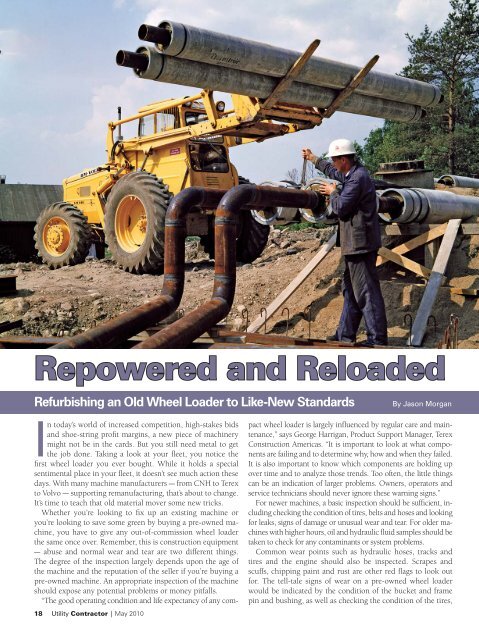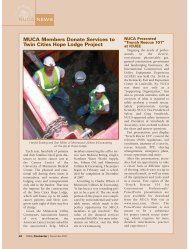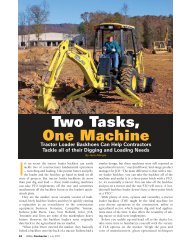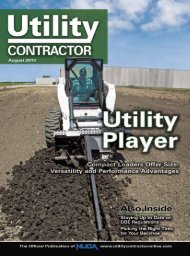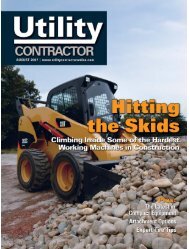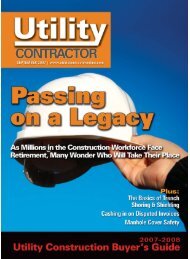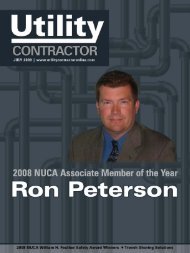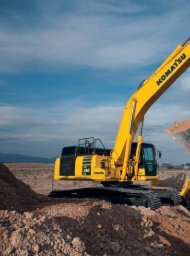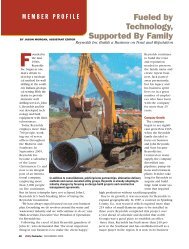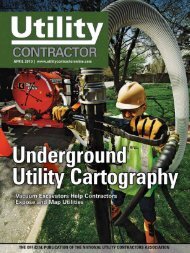View Full May PDF Issue - Utility Contractor Online
View Full May PDF Issue - Utility Contractor Online
View Full May PDF Issue - Utility Contractor Online
You also want an ePaper? Increase the reach of your titles
YUMPU automatically turns print PDFs into web optimized ePapers that Google loves.
Repowered and Reloaded<br />
Refurbishing an Old Wheel Loader to Like-New Standards<br />
By Jason Morgan<br />
18 <strong>Utility</strong> <strong>Contractor</strong> | <strong>May</strong> 2010<br />
In today’s world of increased competition, high-stakes bids<br />
and shoe-string profit margins, a new piece of machinery<br />
might not be in the cards. But you still need metal to get<br />
the job done. Taking a look at your fleet, you notice the<br />
first wheel loader you ever bought. While it holds a special<br />
sentimental place in your fleet, it doesn’t see much action these<br />
days. With many machine manufacturers — from CNH to Terex<br />
to Volvo — supporting remanufacturing, that’s about to change.<br />
It’s time to teach that old material mover some new tricks.<br />
Whether you’re looking to fix up an existing machine or<br />
you’re looking to save some green by buying a pre-owned machine,<br />
you have to give any out-of-commission wheel loader<br />
the same once over. Remember, this is construction equipment<br />
— abuse and normal wear and tear are two different things.<br />
The degree of the inspection largely depends upon the age of<br />
the machine and the reputation of the seller if you’re buying a<br />
pre-owned machine. An appropriate inspection of the machine<br />
should expose any potential problems or money pitfalls.<br />
“The good operating condition and life expectancy of any compact<br />
wheel loader is largely influenced by regular care and maintenance,”<br />
says George Harrigan, Product Support Manager, Terex<br />
Construction Americas. “It is important to look at what components<br />
are failing and to determine why, how and when they failed.<br />
It is also important to know which components are holding up<br />
over time and to analyze those trends. Too often, the little things<br />
can be an indication of larger problems. Owners, operators and<br />
service technicians should never ignore these warning signs.”<br />
For newer machines, a basic inspection should be sufficient, including<br />
checking the condition of tires, belts and hoses and looking<br />
for leaks, signs of damage or unusual wear and tear. For older machines<br />
with higher hours, oil and hydraulic fluid samples should be<br />
taken to check for any contaminants or system problems.<br />
Common wear points such as hydraulic hoses, tracks and<br />
tires and the engine should also be inspected. Scrapes and<br />
scuffs, chipping paint and rust are other red flags to look out<br />
for. The tell-tale signs of wear on a pre-owned wheel loader<br />
would be indicated by the condition of the bucket and frame<br />
pin and bushing, as well as checking the condition of the tires,


